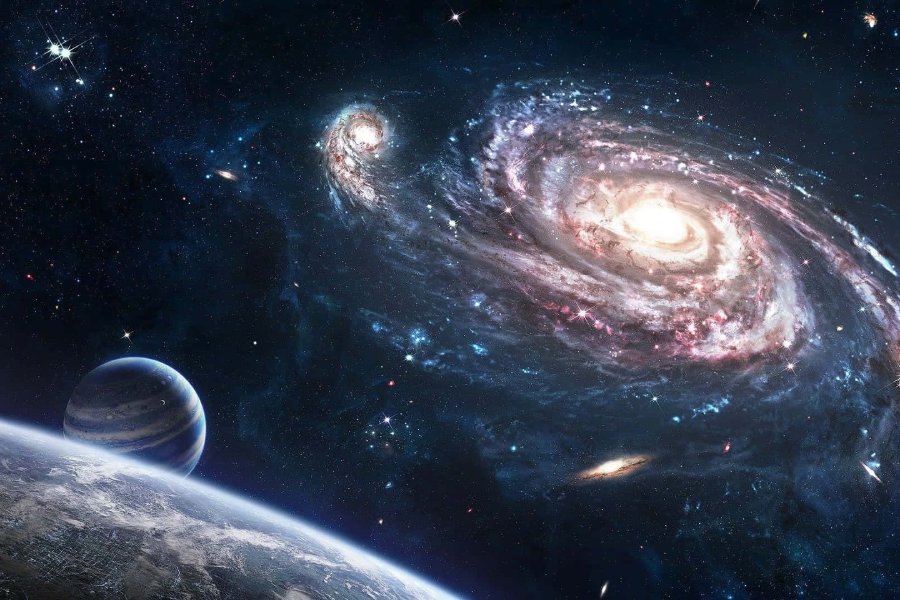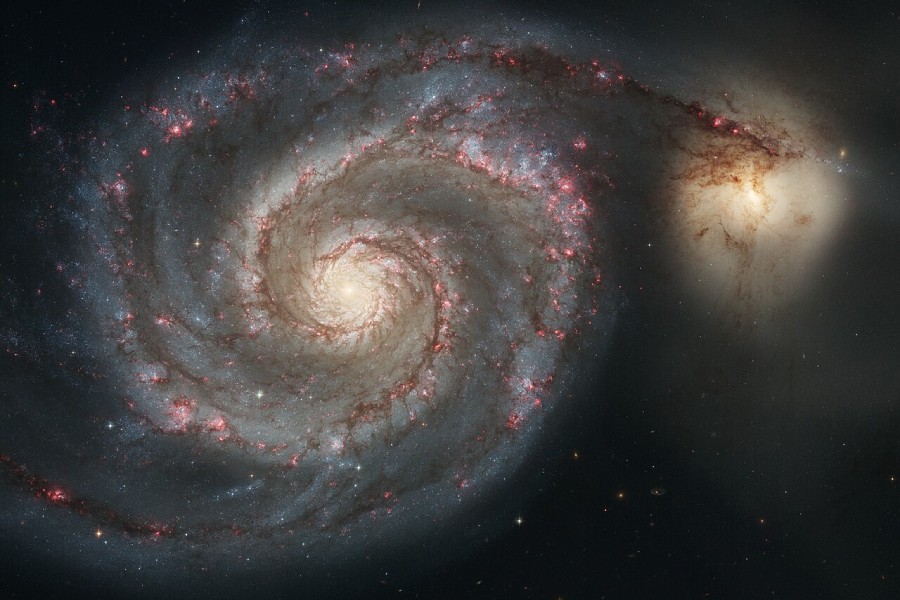When we gaze at the magnificent Whirlpool Galaxy, its swirling arms spin with starry brilliance. How does it compare to the cosmic home we call the Milky Way? These two spiral galaxies shine brightly in our night sky, beckoning from their perches in the universe. But how alike or different are they?
In this article, we’ll explore the Whirlpool Galaxy and the Milky Way. We’ll peer at their structures, stellar populations, and astronomical histories. These explorations will provide clues into their shared traits and divisions.
We’ll tackle questions about their sizes, shapes, and cosmic environments. Do they harbor similar glowing secrets at their cores? Did common galactic forces spur their growth?
As we investigate the Whirlpool Galaxy vs Milky Way key differences, we’ll examine visual evidence from scans across the spectrum to understand how they compare objectively. As we witness their glory and seek answers to their genesis, one thing is assured – our awe of these majestic galaxies will continue to grow, despite the vast gulf of space between them.

Whirlpool Galaxy vs Milky Way – Key Differences
What distinguishes the Whirlpool Galaxy from the Milky Way? The Whirlpool Galaxy is a classic spiral galaxy located in the constellation Canes Venatici, while the Milky Way is a barred spiral galaxy to which our solar system belongs. Some key differences include their locations, structures, and sizes.
The Milky Way is the galaxy in which Earth resides, while the Whirlpool Galaxy is situated millions of light-years away. Structurally, the Whirlpool Galaxy displays well-defined spiral arms, while the Milky Way has a bar-like central structure. Additionally, the Milky Way is larger than the Whirlpool Galaxy in terms of both mass and size.
A Comparison Between the Two Galaxies
The Whirlpool Galaxy and Milky Way are large spiral galaxies with similar structure, composition, and history. But differences in properties also exist. Comparing traits like dimensions, stellar content, nuclei, and past mergers gives insight.
Studying the Whirlpool also sheds light on the Milky Way through an external vantage point. Seeing it face-on reveals structure otherwise obscured from within our galaxy. Exploring twin spirals teaches about the phenomena shaping galaxy formation over time.
Finding similarities and unique aspects refines theories about their complex individual histories. As a large spiral so comparable to our own, the Whirlpool also helps interpret indirect Milky Way data. Similarities give hints about features that are harder to observe within our galactic home.
Characteristics
The Whirlpool and Milky Way are both large spiral galaxies exhibiting central bulges and surrounding disk structures. The Milky Way spans 100,000 light-years, while the Whirlpool is smaller at 60,000 light-years across.
The Whirlpool has very well-defined arms showing lots of star formation, whereas the Milky Way’s arms are more scattered. Their central bars and intrinsic structure also differ somewhat. The Whirlpool’s beautiful face-on spiral against an emission nebula is iconic.
The Milky Way hosts our solar system, making it special to humanity. But its center remains obscured from within. Whirlpool’s grand design of a two-armed structure contrasts with Milky Way’s four major arms, which contain multiple spurs and segments.
This indicates differences in density wave propagation affecting gas flows. While the Whirlpool presents its full spiral disk for inspection, the edge-on Milky Way does not. Instead, the thick disk and halo components of the Milky Way come more clearly into view. These components surround the Milky Way’s plane.
Central regions
Both galaxies have bright, barred central bulges packed with stars, gas, and dust. The Whirlpool’s core has been mapped but the Milky Way’s remains obscured from Earth. At their hearts lie supermassive black holes of very different masses.
The Whirlpool Galaxy appears to be isolated, while the Milky Way has smaller captured satellite galaxies orbiting it. Their bulges at the galactic centers also differ in shape based on the angle we view them.
However, the brilliance of both cores shows their importance in anchoring the surrounding spiral structure. The stellar bars may funnel gas inward to fuel activity in the galactic cores.
Being located within the Milky Way allows more detailed studies than is possible for the external Whirlpool Galaxy. Estimates indicate that Whirlpool’s supermassive black hole is 50-100 times more massive than the one in the Milky Way’s core. Interactions with satellite galaxies like the Magellanic Clouds allow us to trace gas dynamics in the Milky Way.
These tidal effects are hard to examine for an isolated system like the Whirlpool. X-ray and infrared telescopes have revealed giant lobes located above and below the Whirlpool’s disk. These giant radio bubbles provide hints of past energetic outflows from its galactic core.
Objects within each galaxy
Both galaxies contain hundreds of billions of stars, gas clouds, stellar nurseries and clusters, supernova remnants, and other structures. The Whirlpool exhibits more organized spiral arms traced by bright young stars and red emission nebulae.
The Whirlpool is admired for ornamental spiral regions like the Red Spider Nebula. The Milky Way uniquely hosts the black hole Sagittarius A* and our local star, the Sun. The Whirlpool’s companion NGC 5195 galaxy highlights interactions that spur evolution. The Milky Way and its Magellanic Cloud neighbors represent another interacting system.
Stellar populations and composition
As large spirals, both galaxies contain very old stars along with stellar remnants and stellar babies still coalescing from primordial clouds. Their disks hold mixed-age populations. Photometric studies show that Whirlpool’s arms are dominated by young, hot blue stars traceable due to associated H II regions.
The Milky Way’s arms have a more heterogeneous mix of ages. Globular clusters contain some of the most ancient stars – up to 12 billion years old. Hundreds exist around both galaxies, though the Whirlpool has relatively fewer globulars than the Milky Way.
The Milky Way’s bulge also contains older stars on average, while the Whirlpool bulge has regions of younger stellar generations as well from ongoing central star formation.
Galactic mergers
Galaxy mergers are pivotal events, impacting the structure and inducing starbursts. The Whirlpool shows signs of a past merger with the dwarf galaxy NGC 5195 still within it. The Milky Way’s last major merger was billions of years ago.
Mergers redistribute material, altering morphology, star formation and metallicity over time. For the Whirlpool, NGC 5195 would have funneled gas to feed central black hole activity.
Despite proximity in Earth’s sky, the galaxies are separated by 35 million light years with no ongoing interaction. However, their cosmic dance still influences perspectives on galactic evolution and future discoveries.

Conclusion
As we close this galactic tale of two galaxies, we hope that scrutinizing the Whirlpool vs our own Milky Way has crystallized their cosmic kinship while also revealing their unique traits. We explored the forces steering their evolution across eons against the universe’s web.
This exploration sparked stellar nurseries that glow through space and time. While divided by 35 million lightyears, linked origins and morphology bind them. With its bar and majestic arms, the Whirlpool no longer seems so foreign or peculiar. Rather, the Whirlpool Galaxy mirrors the glory of our Milky Way home – an island awash in ancient starlight.
As we continue exploring new frontiers in their stars and dust clouds, we hope this comparison of the Whirlpool Galaxy vs Milky Way has illuminated some of the key similarities and differences between these wondrous twin spiral galaxies.
